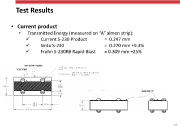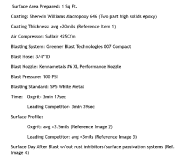We had an opportunity to speak with Charlie Gorman from Sinto America headquartered in Grand Ledge, MI.
Charlie is the Vice-President of the surface treatment division focusing on the manufacturing of Frohn cut-wire, cast medias and the Sinto line of shot peening and blast-cleaning equipment.
(?) MFN: Charlie, thank you for taking the time to allow MFN to have an interview with you. How has Sinto been affected by the market changes and complexity we’ve all experienced over the past two to three years?
(!) C. G.: We’ve seen some of our major market segments such as aerospace and medical customers slowed down significantly. Fortunately, these segments have made a good recovery in 2022. We still see some challenges in these two segments but sales are certainly recovering.
(?) MFN: Were there any specific actions you took to mitigate these challenges?
(!) C. G.: We have focused on market segments that were not negatively affected by the pandemic. Applications like blast cleaning have offset our drop in sales in our other market segments such as aerospace shot peening. The foundry and forging market segments have experienced more robust activities over the last 2-3 years. We saw this as a way to broaden our customer base by replacing cast shot with cut-wire shot to remove sand and heat-treat scale on castings and forgings. Both cut-wire shot and Rapid-Blast, which is a cut-wire and cast shot blend, will reduce cycle times and costs. These products will improve cleanliness of castings and reduce costs in the post blast step, such as machining. This works out well for a number of our customers.
(?) MFN: How can a product sell for 3X and save money for your customers compared with their current cast shot?
(!) C. G.: The carbon steel wire, which is the raw material for cut-wire shot, being discussed is cold-wrought through a die which provides a nearly perfect microstructure. This microstructure provides in some cases double the life of cast shot. The near-perfect microstructure also provides higher density which increases the transmitted energy of the particle by 65% compared with the same size particle of cast shot. Considering the higher transmitted energy of cut-wire, the combination of lower consumption and shorter cycle times results in overall LOWER blast-cleaning costs.
(?) MFN: Why doesn’t everyone use cut-wire shot if it results in lower blast-cleaning costs?
(!) C. G.: Cut-wire shot has traditionally been used for parts and applications of higher value, such as aerospace shot peening and some automotive components. It is considered too expensive for sand and scale removal.
In some cases, our customers have already tested cut-wire shot, but the tests were unsuccessful for any number of reasons.
In our recent trials, sometimes we must reduce the size of cut-wire shot more than we thought necessary in order to meet finish requirements. The higher transmitted energy, the greater the uncertainty of the size of cut-wire shot since the way of energy transmitted affects the surface finish. In basic terms, the higher transmitted energy allows us to reduce the size of cut-wire shot by one or two sizes, which results in a higher particle count per pound of abrasive thrown by the blast wheel. The higher particle count increases the number of particles thrown by the blast wheels per minute, which will increase the coverage and cleans the surface more quickly. Since the transmitted energy affects surface finish differently depending on part hardness and type of machine used, it is a more iterative process sometimes.
(?) MFN: What criteria are used to determine whether the cut-wire shot is an option for a foundry or forging location?
(!) C. G.: In order to provide benefit for the cut-wire shot, it must be kept in the machine. Therefore, leaks and carryout are obviously not desirable. The shop must have fairly comprehensive maintenance and production programs to ensure that the machines don’t leak or the leakage and carryout are loaded back into the machine and reused. Management must also be aware that process cost savings can be spread throughout multiple process steps and departments, with the reduced energy consumption due to shorter cycle times as a good example. The savings will show on the P & L in a different area rather than production cost.
(?) MFN: What if carryout and/or leakage cannot be controlled?
(!) C. G.: Thanks for asking this. This is the reason why we have developed our Frohn Rapid-Blast product. Rapid-Blast is a blend of cast shot and cut-wire shot, which reduces the price point so that it is much closer to that of cast shot, enabling our customer to realize many of the benefits of cut-wire at a price point more similar to what they are currently paying for. The same principles apply as shown in the below images showing Ervin test machine results comparing cast S-230 with Frohn S-230RB Rapid-Blast.
In terms of transmitted energy, the below image demonstrates the increased energy transmitted to the almen strip in the Ervin test machine. The transmitted energy can be considered as improved cleaning potential, i.e. the cycle time reduction.
(?) MFN: How do you manage the different breakdown rates of the cast shot compared with the cut-wire shot in the blend since the cast shot is consumed so much more quickly.
(!) C. G.: Another good question. We start the blend with an approximate 30% cut-wire shot and 70% cast shot depending on the application. We can maintain this ratio with a 15/85 blend after the start-up is successfully completed due to the lower consumption rate of the cut-wire shot in the blend. This brings the price down even more to a point where the monthly abrasive consumption is actually reduced even though the Rapid-Blast product is higher in price.
(?) MFN: This certainly sounds disruptive. We wish you luck in your efforts. Have there been any other developments recently?
(!) C. G.: As a matter of fact, yes. We will also introduce our Frohn Duramax Oxgrit product in 2023, which is used for surface preparation applications in the contractors and industrial market segments. Coating, rust, scale removal, and surface profile generation are the main applications. The main competitive products will be slags, garnet and aluminum oxide. Oxgrit is a steel oxide that has high bulk density, 7.0 – 7.5 mohs hardness, very low consumption rate compared with slags due to the way the raw material is atomized, and environmentally much cleaner than any competitive product. The cleaning rate of Oxgrit is also faster than competitive products due to the improved microstructre.
Traditional copper, coal, and nickel slag is allowed to cool and then crushed to size resulting in high consumption, and the “one and done” use generates a great deal of dust disposal cost and environmental impact. Oxgrit manufacturing includes an atomization step creating a microstructure within the particle, which is our competitive advantage. It provides much lower consumption (5-10 recycles), higher transmitted energy due to the improved microstructure, and recyclability to which the competitive products cannot match. The cleaning rate of Oxgrit is even more quick than garnet, and the recylcability makes the Oxgrit the clear choice for many applications. See below test done by a 3rd party to confirm performance compared with garnet.
(?) MFN: So a coarser Oxgrit can remove the coating 11% more quickly even though it is a coarser product?
(!) C. G.: Yes, at the time of trial we produced a limited size range and this (36X) is what we have available. The higher profile results aren’t surprising for this reason but the cleaning rate improvement is. One of our customers told me, “this stuff cuts like a scalded cat.” I thought that was a good description. Added to the faster cleaning rate is the lower consumption and compared with the aluminum oxide, a price point at about half of what they are now paying for. All good reasons require to at least test Frohn Oxgrit to see if it will work for the customer.
(?) MFN: Thank you for taking the time to conduct this interview with MFN. We wish you the best in 2023.
(!) C. G.: Thank you so much for allowing Sinto/Frohn to discuss what we have been working on over the past 2 years. We are excited to see how we can positively affect our industry and our world. If anyone would like to discuss a trial or ask any questions, I can be reached at charlie.gorman@sintoamerica.com.
MFN would like to thank Charlie Gorman for this interview!
For Information:
ROBERTS SINTO CORPORATION
A SINTO AMERICA, INC. COMPANY
150 Orchard Street
Grand Ledge, MI 48837, USA
Tel. +1.517-371-2460, Fax +1.517-371-4930
E-mail: Charlie.Gorman@sintoamerica.com




































